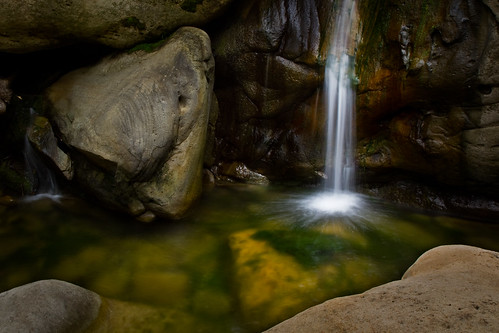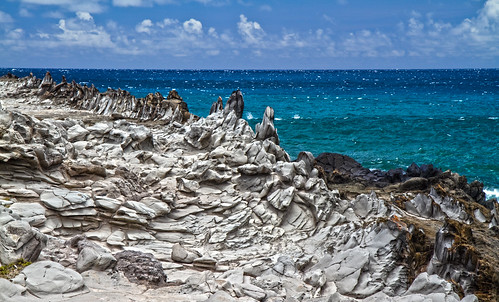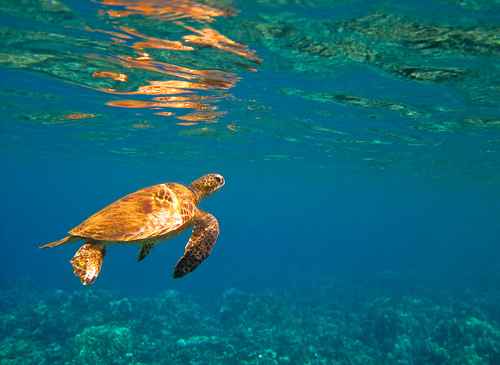Via Flickr:
This past weekend I got to steal away for a hike with my friend Steve. We decided to tackle the "Three Pools Beyond Seven Falls" trail in the mountains just behind Santa Barbara. The trail is steep and exciting, and follows a creek that was surprisingly full for this time of year.
The trail was pretty overgrown, though, and gingerly picking our way through all of the poison oak bogged us down a lot. We ultimately ran out of time before we could reach the pools, but the falls and small pools we saw on the way were well worth it. Next time, we decided, we're wearing jeans and bringing a machete :).
This waterfall was a highlight--it's right at a point on the trail where the only way onward is to scale a 15' boulder to the left of this scene. Definitely got my heart racing :).
Monday, June 13, 2011
Waterfall Along Seven Falls Trail
Dragon's Teeth
Via Flickr:
We had a lot of fun exploring the northern coast of West Maui. There are many spots along that part of the coast where you can find some amazing lava rock formations jutting out into the ocean, and walk down to get a front row seat to the ocean's fury (more of that to come :) ).
The unique formation on this particular point is known as "Dragon's Teeth".
I thought the HDR treatment here did a nice a job of accentuating all of the wild jagged edges, which is really what makes this spot so unique. The HDR process ruined the sky, so I replaced it with the original, and also blended back in some of the original ocean to soften the affect there.
I used the HDR tool in a trial of CS5 (instead of Photomatix), and I have to say, I really liked it. I may have to make the upgrade from CS4... :)
Wednesday, May 25, 2011
Maui Tide Pool
Via Flickr:
This was part of some tide pools out in front of The Gazebo, a popular breakfast spot out in West Maui.
There wasn't a whole lot of life in the pools, but I liked the crescent shape of these urchin, and they were in some nice soft light in the shade of a boulder. I didn't realize at the time how much color was hiding under the water!
There was glare on the water that made everything look kind of muddy (check out the unedited original). This would have been a perfect use of a polarizing filter to cut the reflected sunlight (I even own one!), but I either didn't bring it or didn't think to put it on :(. I managed to workaround the glare in processing by pushing the exposure and pulling up the blacks to add more contrast back in.
Wednesday, May 18, 2011
Maui Sea Turtle
Via Flickr:
For our vacation to Maui (without the kids!), we decided to pick up an underwater point-and-shoot to play with. We settled on the Canon PowerShot D10. I'm so glad we got it!
It was tough to use at first... You have to look past any water drops or fog in your mask at a small LCD screen, and it can be really tough to make out what the camera is actually pointed at. And, to make an interesting composition, I think a lot of the time you want to get down close to the ground and shoot up at the fish, so that you have the blue ocean as your background and not the sea-bottom. So you have to hold your breath, swim down (fighting the salt water and your bouyant gear to stay down), try to hold the camera steady, and make out the composition on the screen. Yeah, it's as hard as it sounds.
I feel like I've started to get the hang of it, though (for one, I've found it's easier in deeper water), and I think this shot proves it's worth the effort :).
Tuesday, March 8, 2011
Campus Point Moonlight
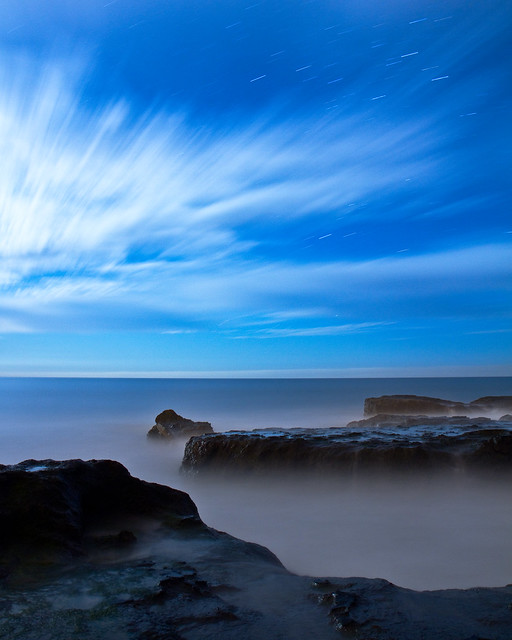
This was from my first real outing with our new Canon 7D. It was glorious :).
I took my test shots at ISO 3200 and f/2.8, then multiplied the shutter speed by 64 to shoot the final image at ISO 200 and f/5.6. The exposures were a little over six minutes.
Luckily, I was with Patrick, and he spent that six minutes with me while I stressed over how close the waves were crashing to my tripod :). Check out his shot here.
Thursday, January 27, 2011
Hendry's Sunrise
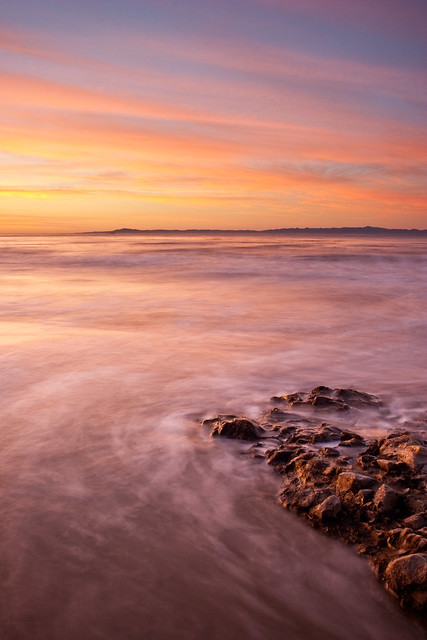
This was from a beautiful morning last October; I can't believe how long it's been since I took this!
I'm sitting on a pile of unprocessed images right now--the problem is it takes me a good 2 hours to process and share a photo like this, and I prefer to do it all in one sitting. It's a little rare lately that I have that kind of time, plus the energy to be able to commit to seeing it through.
On top of that, they all feel like "4 out of 5 stars", so I'm not dying to share them. It seems important, though, to finish what I started, and to get my work out there so I have something to show for it. And if nothing else, I want to be able to look back at what I've been shooting and watch my progress!
I shot this image at f/22 to slow the exposure, even though I knew my sensor was pretty dirty. The resulting dust spots were a nightmare--I did a rough count of my spot removals in Lightroom... There were 60!
Here's the original, unedited image.
Tuesday, January 18, 2011
Line
One of the biggest hurdles for me has always been the fear that without some inborn artistic ability I would never become a decent photographer. My experience has gradually taught me otherwise, though, and the arguments in this book have completely blown that thinking out of the water for me.
I'm excited, now, to apply these concepts to improving my photography. Over the years, I've gradually learned that becoming a great photographer is not so much about learning how to use all the features on a camera and all of the tools in Photoshop, but more about becoming an artist who can recognize the beauty in a scene and use those tools to bring it out.
I'm not going to photography school, or even photography class (at least while there's two toddlers at home), but I do have some good books and friends to help guide me. I'm going to have to be mostly self-taught in my spare time, but I'm encouraged by Colvin's anecdote of Benjamin Franklin, who practiced to become an accomplished writer while working full time at a printing press and relying on the works of other greater writers as a guide.
For my first exercise, I'm exploring the concept of line. The exercise has evolved a bit as I've worked on it, but here it is in the form of an assignment:
Take at least 20 pictures of line, with 10 in man-made environments, and 10 in nature.
- The emphasis is on form over content--the images don't have to be interesting, just demonstrate a concept.
- In the man-made environment, the images have to be unique in terms of what type of contrast (light and shadow, different textures, etc.) creates the line. This is because man-made lines are abundant.
- In nature, I didn't apply this restriction--the images can be of any naturally occurring line. This is because I mostly shoot in nature and I simply want to learn to recognize all of the lines I encounter in the places I typically shoot.

The emphasis on form over content is helpful because it means I can shoot these images easily at any time, even on my lunch break when the light is harsh and terrible :).
Also, I quickly realized that there are many different uses for lines--horizontals, verticals, diagonals, and curves all have different qualities. Some lines lead the eye along them, others serve as a frame or a lens to focus your attention.
For this exercise, though, I focused on simply what defines a line. I want to be able to recognize all of the lines in a scene--both to recognize what lines are available to use in making my composition, and to recognize any lines that might be interfering with my shot. All too often I pull the images off the camera at home and spot distracting lines that I didn't see while I was shooting.

With all that out of the way, here is the full gallery of my results!
The images also seemed to become an exercise in minimalism (if I'm using that label correctly), because I always tried to isolate the line as much as possible from any surrounding distractions.
Overall, I think the exercise was a success. I'm finding that when I look at a scene or an image now, I'm paying much closer attention to where there is contrast. Perhaps most significantly, I think practicing this as an exercise has also caused me to look more critically and deliberately at a scene--to be less distracted by the exciting natural beauty and to be more focused on what design elements are available in front of me.

Finally, it's been abundantly clear while doing this that "line" is far from everything, and there are many more forces at work in an image to learn about. I'm excited to move on to the next one!
